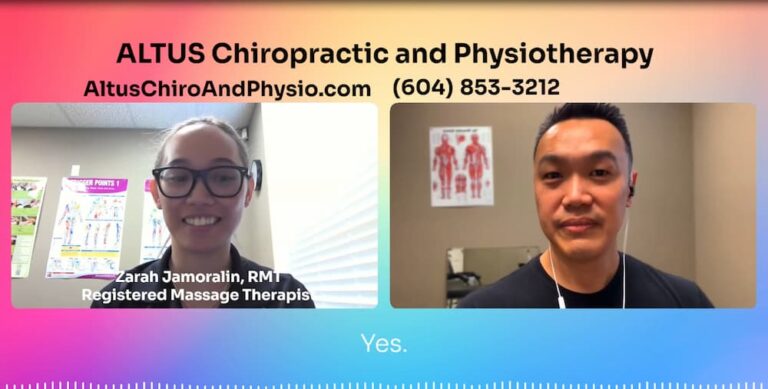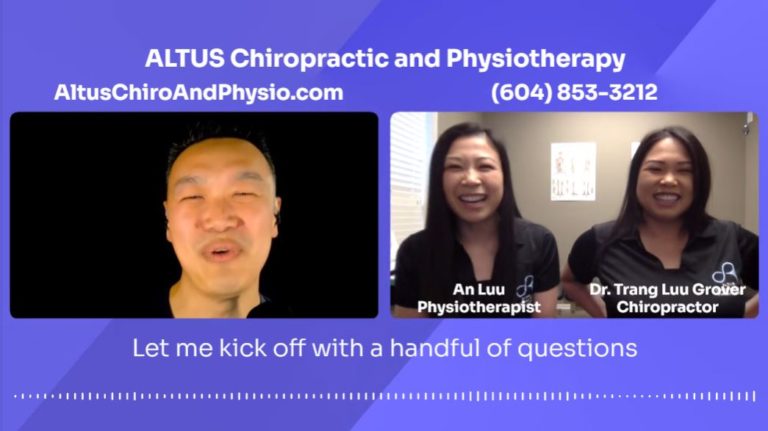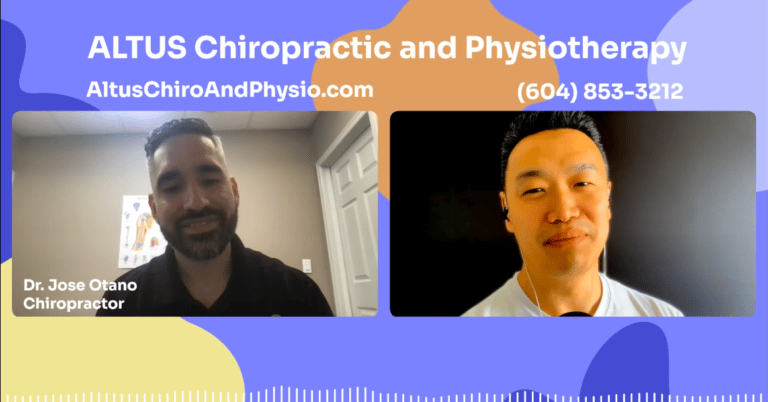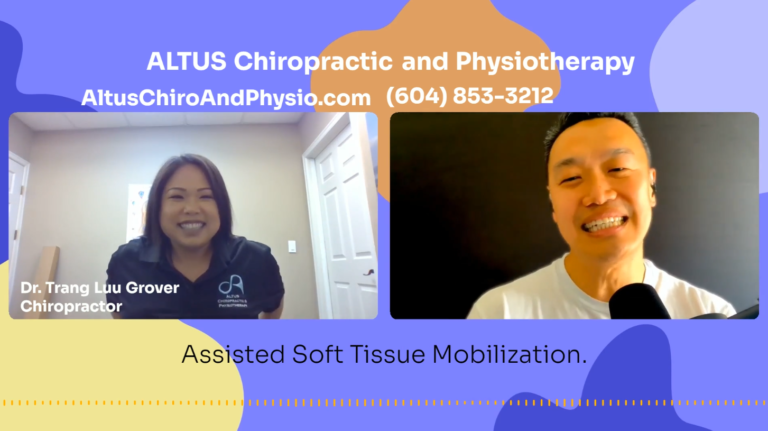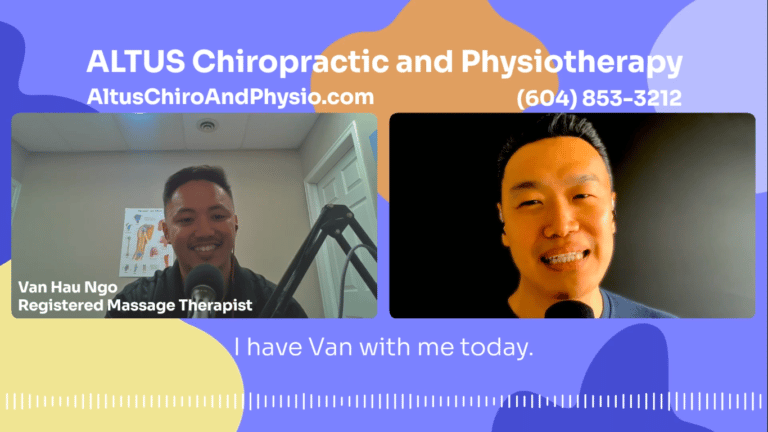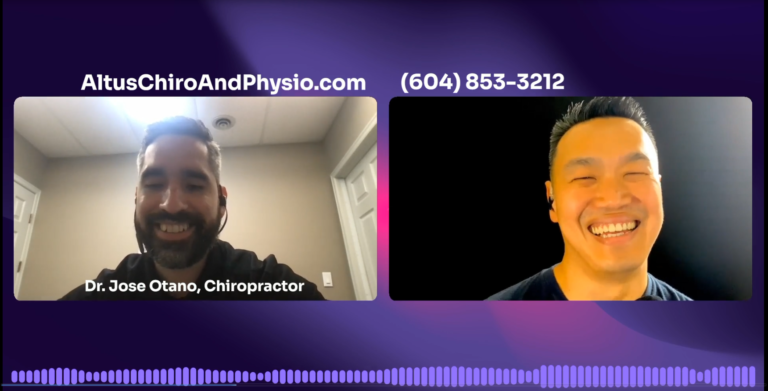Show Notes
[00:00:00] Sherman Hu: Hello, everybody. Thanks for joining us for another episode of the ALTUS Chiropractic and Physiotherapy podcast. I have the wonderful Judy Todd with me today. Hi Judy.
[00:00:08] Judy Todd: Hello. How are you?
[00:00:09] Sherman Hu: Very well. Thanks for joining us for the first time on this episode series, and I know that you are wanting to unpack a bit about the hip and knee replacement topic on today’s podcast.
What is the role of a Physiotherapist in Joint Replacement Surgery?
[00:00:24] Sherman Hu: So what’s the role of the physio in guiding clients with their joint replacement surgery?
[00:00:31] Judy Todd: I divide this up into two parts, the before and the after.
[00:00:36] So before the surgery, I’m quite often already seeing the person who’s suffering from arthritis in their hip or their knee. And we know that they possibly moving towards having a total replacement.
[00:00:50] So my role as a physio is to keep them as pain-free as we can, keep the pain under control. We know there is pain. That’s one of the biggest criteria is for getting rid of a [00:01:00] joint.
[00:01:00] Two, so managing the pain and maintaining range of motion. That’s the biggie is that they don’t get really stiff before the surgery. Maintaining strength so that they come out with a better outcome.
[00:01:12] We do a lot of work on gait training. We get people ready for the surgery by working out whether they’re going to need a walker or crutches or a cane and teach them to use these devices. And make them safe with their transfers and make sure that whatever they’re going to use is measured for them. So they’re not at the wrong height of the handles.
[00:01:31] And then we’re getting them ready for post-op by saying, “How is your home set up? Do you have stairs? Do you have a family member who can be with you? Where’s your family team?”
[00:01:41] Understand that they have to commit to helping you get through this.
[00:01:44] Things like long-handled grabbers for picking things up off the floor.
[00:01:49] If you’re going to get a hip replacement, possibly even with knees, you want raised toilet seats ready to go.
[00:01:54] Raised cushions in your best chairs.
[00:01:57] So you know that your home is [00:02:00] ready for when you come out of the hospital. No surprises when you get home.
[00:02:04] And then get the equipment ready for, you might need cryo cuffs, which are the ice machines to help keep the swelling out of your knee.
[00:02:10] What kind of medications the doctors might be prescribing for you and how to manage pain with other ways, non-chemical ways.
[00:02:20] And there’s a wonderful booklet that Fraser Health and all the other health districts put out that we make sure that they’ve seen, they’ve got that. And then they will be given that one when they go into the hospital to get the pre-op, which they’ll have with the usual pre-ops team of people that they see.
[00:02:37] Then the big day comes, then they come home.
[00:02:40] Now we see the hip replacements less often they’re much easier to get through. They usually come to me at about three weeks post-op, by when the staples are out, the wound is healing. They’re walking with partial weight.
[00:02:52] The knee replacements, however, we like to see them really early. I’m usually seeing them at about seven days post-op. They still got a line of [00:03:00] staples in. And then the second time I see them when we got the staples out and we start gaining range and other things, very early on with knees, cause they need a lot more work.
[00:03:10] So our job is to obviously manage the pain, reduce inflammation, speed up healing, return to the pre-anticipated range of motion and strength for their age and ability pre-surgery. Incision management, biggie making sure that they don’t let them get a lot of scar tissue.
[00:03:26] Basically supervise the home program. These people have to be on a very strict home protocol. So we’re going to manage, we know what they’re doing and we’re adjusting it, modifying it, and just giving them the encouragement. And eventually, they are going to go back to full function. So we helped them return to work, sports, whatever is the right timing, cause everybody’s going to be different. So you can’t just check on a website and find out that oh, I can’t get back on the ski slopes first three months, six months, depending on their age and their previous fitness levels.
[00:03:58] So that’s what the physio is involved with [00:04:00] is the bit before the surgery, and then the really important part after the surgery.
[00:04:05] Sherman Hu: That’s brilliant. And because I did not know any of this is amazing information for me to know.
What is the role of a Physiotherapist in Joint Replacement Pre and Post Operations?
[00:04:11] Sherman Hu: Out of my ignorance, I’m wondering if most of the work of physios comes post-op or if are there any clients that come in pre-op?
[00:04:20] Judy Todd: I would say most of my clients have already been seeing me for a long time. You don’t decide overnight, you’re going to get rid of your knee. So these are the people I’ve been struggling with them with we’re getting by the ends, nowhere fast. So then it’s fine to make that decision together.
[00:04:35] So most of these patients I already know, but a lot, I don’t. I see them post-op for the first time and that’s fine too. We work it out. But it’s kinda nice to have a bit of a relationship with the person first. Then they know what to expect from you later.
What can clients expect coming into the clinic post-surgery?
[00:04:50] Sherman Hu: I’m curious. Judy, what can a client do, you already have a relationship with them, but what can they expect coming into the clinic, post-surgery?
[00:04:59] Judy Todd: If [00:05:00] you’ve had a knee replacement, you can expect it to be quite painful. I won’t mess around with that. It is a very, it’s big surgery.
[00:05:06] I am talking about total replacements, not partial replacements, which are a lot easier or resurfacing of hips and stuff like that. So I’m talking about where the whole part of the joint has gone and they’ve got a new prosthesis in at each end. So this is the big surgery.
[00:05:21] So yes, the rehab is, for knees, it’s very tough. For hips, it’s a lot easier. But knees do require a lot of strength of character, I think to get through that. And the knees don’t just stop bending right away. You have to ask for every degree of movement, you have to work for it. So it’s not easy. I’ll admit that it’s not easy.
What can a client expect after a joint replacement surgery?
[00:05:45] Sherman Hu: What can a client anticipate as far as the outcomes go? I know they probably know this is not an easy ride. But what can they anticipate or expect for the outcome?
[00:05:56] Judy Todd: Down the road, you’re going to get rid of the pain that [00:06:00] drove you to the hub to see the surgeon in the first place. So you’re going to swap initially the pain from arthritis before the surgery to postoperative pain, but that post-op pain will go.
[00:06:10] Bit by bit, it will go. More lengthy with knees, of course, then with hip replacements, which are much easier. So along with getting rid of pain we’re getting that range back. We’re going to get the strength back and we’re going to get them back to their, what we call ADLs, your activities of daily living. Again, so these are people who maybe have not been able to push a lawn mower. Now they can do that again. Or back into sports because they’re, designed now that we can play sports within reason. So guide the person on how they’re going to get back to their tennis or their skiing, or their running.
[00:06:47] Well, we don’t often recommend running, but helping them back into is certainly extensive walking, hiking, going up and down hills, getting them back to function again. So eventually that will be done [00:07:00] without pain. Not always a hundred percent without pain. There are sometimes people who still have pain a while later, but most people do get rid of the pain that they have before the surgery is gone.
Can pain after joint replacement surgery be measured?
[00:07:11] Sherman Hu: Would you say, Judy, that’s an 80-20 percentage split? 80% can be pain-free and 20% still experience some pain?
[00:07:18] Judy Todd: It depends on what you’re talking about with pain. Cause that’s very complex. A lot of people have pain. Let’s say you’ve had your hip replaced, but you’ve still been walking so badly because of the hip that you’ve now upset your back and your SI joints, your lumbopelvic junction is all out of whack as well.
[00:07:34] So you can get rid of that hip, get a nice new hip in there, but you still got the pain from the next joint up. By the time people have these surgeries, it’s not just one joint that’s affected. So how do you answer that question? Do some people carry on having pain from other joints? But the original pain from that hip, let’s say, that’s gone. So they might’ve stressed their knee all the time that they were trying to limp because of their hip. You [00:08:00] can’t really put a percentage on it.
[00:08:02] Sherman Hu: Judy, my hip has no more pain, but there’s still a pain in the behind.
[00:08:06] Judy Todd: Exactly. Exactly.
[00:08:08] Sherman Hu: Oh, that was great.
What’s the cost of joint replacement surgery? Is joint replacement surgery covered by insurance?
[00:08:09] Sherman Hu: Judy, what is the cost or financial outlay? Is it covered by insurance? What’s your perspective on that?
[00:08:15] Judy Todd: If you live in Fraser Health and you get your hip only replaced, let’s say at ARH or one of the local Fraser Health hospitals, then you’re entitled to go and get post-op physio at that hospital.
[00:08:28] So the hospital department has an outpatient department that is specialized in helping you get through your hip or knee replacement. That doesn’t cost you anything, it’s a hospital visit. So you don’t pay for anything. At the end of your time, particularly with the knees, the hips, like I say, they breeze through.
[00:08:45] But I have some patients who’ve had some physio at the hospital and then they want to get a little bit more range with their knee, or they’re not happy with the stability or they feel like they wanted to go a little further, then they’ll come back and see me. Then it’s a typical clinic visit [00:09:00] where hopefully the insurance, they have insurance coverage so that, most of my patients come from Vancouver Coastal Health.
[00:09:07] So UBC has a program where they don’t want you to have to drive all the way back out to UBC to get your physio treatment every week. So they cover for three treatments. If you’ve had a hip replaced and they cover for 12 if you’ve had a knee replaced. So you come out of the hospital with your a little piece of paper that we fill in and we send it back in and we bill them directly.
[00:09:31] So there’s no cost again unless you need more than 12. Sometimes people do. Most of the time we can get them done well within the 12. So there’s actually no cost on the rehab at all. And you can rent your equipment from the Red Cross, like your raised toilet seats or whatever. You might put a donation into the Red Cross or whatever. So generally it’s not an expensive outlay. No.
What are the advances in technology in Joint Replacement Surgery?
[00:09:53] Sherman Hu: Judy, in the realm of the world of joint replacement, have there been changes or advances [00:10:00] in technology or research or application that our viewers could learn from?
[00:10:04] Judy Todd: Definitely. Right back to starting off with hospital stays, they are way shorter. It used to be back in the old days you were in for a week.
[00:10:12] Now, one night, maybe two, depending on your fitness levels, your age, and other things, your health prior. There are way less complications. Hips are not dislocating like they used to, knees are not getting infected like they used to, and the incisions are smaller in both hips and knees, but particularly hips.
[00:10:30] The incisions are not nearly as long. Recovery time is way quicker. The management of pain is way better. The medications that the doctors and surgeons prescribe doesn’t seem to make peoples as unwell as it used to in the old days, but definitely quicker return to function. And we’re starting to see bilaterals going on.
[00:10:49] That means that you can get, this is very rare, but you could get both hips done at the same time or both knees at the same time. It’s not common. You have to go out of province to get those hips done at the [00:11:00] same time. I believe there’s still nowhere in BC. I know people are going to Quebec to get both knees, and both hips are done, but I’ve had out of UBC. I’ve had both knees at the same time. That requires an awful lot of rehab, but it’s and that never would have been done in the past.
[00:11:14] So the outcomes are definitely better than they used to be in the old days. And they’re lasting longer. So in the old days, a knee replacement, they say you’ve got maybe 12 years out of this.
[00:11:23] Now I’m not seeing patients within 20 years. And they still got the same hip or knee replacements. They’re lasting longer, are made of better materials, and less reactions.
[00:11:35] Sherman Hu: That is incredible.
What’s your advice for someone contemplating joint replacement?
[00:11:35] Sherman Hu: As we wrap up today’s episode, Judy, what would your best advice be for someone who’s contemplating a joint replacement?
[00:11:41] Judy Todd: First of all, once they’ve been approved to be a candidate, obviously by their doctor and their surgeon, and they’re on the list. I still have patients who stall at that point and see, ya know, but I’m doing okay and I’m watching them walking off and they’re barely functioning.
[00:11:57] Because they’re nervous that when they have the surgery, they [00:12:00] won’t be in a better place, but they will. So my advice is always, to go for it sooner than you think because there’s a waiting list. It’s five months to see a surgeon and another year sometimes before your surgical name comes to the top of the list.
[00:12:15] So why wait, these are your golden years. Why wait till you spiral down so debilitated that then the surgery is that much harder to go through? So don’t wait. These are your golden years, so go fill your boots.
[00:12:28] Sherman Hu: That’s wonderful. Judy, thank you for sharing so much information about hip and knee replacements, and for someone who doesn’t know anything about it, I’m glad to know that.
[00:12:38] Judy Todd: Hopefully it’ll be a long time before knocking on the door. Yeah.
[00:12:41] Sherman Hu: That’s right. That’s right. For viewers who are tuning in stay tuned next week, as we cover more physiotherapy and chiropractic topics with the ALTUS Chiropractic and Physiotherapy podcast.

